Articles
Detrital zircon signatures in Precambrian and Paleozoic sedimentary units in Ganderia and Avalonia of southern New Brunswick, Canada – more pieces of the puzzle
ABSTRACT
Southern New Brunswick consists of a collage of fault-bounded belts of Late Neoproterozoic igneous and metamorphic rocks, early Paleozoic sedimentary, metamorphic and igneous units, and overlying Carboniferous and locally Triassic sedimentary rocks. The area also contains the boundary between Avalonia and Ganderia as interpreted in the northern Appalachian orogen. New detrital zircon ages reported here provide improved understanding of depositional ages and provenance of diverse Neoproterozoic to Carboniferous rocks in this complex area. Detrital zircon data from samples with Neoproterozoic maximum depositional ages indicate a dominantly Gondwanan provenance with strong influence from the Amazonian craton. However, quartzite from The Thoroughfare Formation on Grand Manan Island contains dominanly 2 Ga zircon grains, consistent with derivation from the West African craton. The age spectrum is similar to that of the Hutchins Island Quartzite in the Isleboro block in Penobscot Bay, Maine, strengthening the possibility of correlation between the two areas. Cambrian samples also show prominent peri-Gondwanan provenance with strong influence from Ediacaran to early Cambrian arc magmatism. The maximum depositional ages of these samples are consistent with previous interpretations of Cambrian ages based on fossil correlations and field data. A Carboniferous sample from Avalonia shows a significant contribution from Devonian magmatism as the youngest detrital component, although its depositional age based on field relationships is Carboniferous. The results exemplify the need to integrate multiple datasets in making interpretations from detrital zircon data.
RÉSUMÉ
Le sud du Nouveau-Brunswick est constitué d’un collage de ceintures délimitées par des failles de roches ignées et métamorphiques du Néoprotérozoïque tardif, d’unités sédimentaires, métamorphiques et ignées du Paléozoïque précoce, ainsi que de roches sédimentaires sus-jacentes du Carbonifère et, par endroits, du Trias. Le secteur comprend également la frontière établie entre Avalonia et Ganderia selon son interprétation à l’intérieur de la partie septentrionale de l’orogène des Appalaches. De nouvelles datations de zircon détritique rapportées ici permettent une meilleure compréhension des âges sédimentaires et de la provenance des diverses roches néoprotérozoïques à carbonifères dans ce secteur complexe. Les données relatives au zircon détritique obtenues des échantillons faisant état d’âges sédimentaires remontant au maximum au Néoprotérozoïque signalent une provenance en prédominance gondwanienne avec une forte influence du craton amazonien. Le quartzite de la Formation The Thoroughfare sur l’île Grand Manan renferme toutefois prédominament des grains de zircon de 2 Ga, ce qui correspond à une dérivation du craton de l’Afrique occidentale. Le spectre de l’âge est similaire à celui du quartzite de l’île Hutchins à l’intérieur du bloc Isleboro dans la baie Penobscot, au Maine, ce qui renforce la possibilité d’une corrélation entre les deux secteurs. Les échantillons du Cambrien font eux aussi état d’une provenance périgondwanienne prononcée, marquée d’une forte influence d’un magmatisme d’arc de l’Édiacarien au Cambrien précoce. Les âges sédimentaires maximaux de ces échantillons correspondent aux interprétations antérieures des datations du Cambrien basées sur des corrélations de fossiles et des données d’échantillonnage sur le terrain. Un échantillon du Carbonifère provenant d’Avalonia révèle une contribution prononcée du magmatisme dévonien à titre d’élément détritique le plus récent, mais son âge sédimentaire le situe au Carbonifère d’après les relations établies sur le terrain. Les résultats illustrent la nécessité d’une intégration de plusieurs ensembles de données pour effectuer des interprétations à partir de données provenant de zircon détritique.
[Traduit par la redaction]
INTRODUCTION AND GEOLOGICAL SETTING
1 Southern New Brunswick consists of a complex assemblage of three fault-bounded belts of mainly Neoproterozoic rocks with minor Paleozoic rocks termed (from southeast to northwest) Caledonia, Brookville, and New River, as well as five belts of mainly lower Paleozoic rocks termed Kings-ton, Mascarene, Annidale, St. Croix, and Fredericton (Fig. 1a). The area spans the boundary between Avalonia and Ganderia as defined by Hibbard et al. (2006), who placed the northern edge of Avalonia at the Caledonia-Clover Hill Fault that forms the boundary between the Caledonia and Brookville belts (Fig. 1b). In this interpretation most of New Brunswick, including Grand Manan Island, is considered part of Ganderia, as is adjacent New England (e.g., Fyffe et al. 2011; van Staal et al. 2011), whereas Avalonia extends offshore into the Bay of Fundy from the Caledonia belt of southern New Brunswick, underlies the Gulf of Maine, and re-emerges onshore in the Boston area of southeastern New England (Thompson et al. 2010).
2 The definition of Ganderia and Avalonia in the northern Appalachian orogen is based on multiple lines of evidence including differences in stratigraphy, magmatic and metamorphic histories, isotopic characteristics, and (increasingly) detrital zircon signatures which can provide information regarding source areas for present components of Ganderia and Avalonia during their pre-Appalachian evolution. The distribution of ages of detrital zircon grains in sedimentary units is a means of comparing units of similar age located in different areas, as well as an indicator of provenance. In addition, the youngest detrital zircon grains give an indication of maximum depositional age, significant in units where other age constraints are minimal or lacking. All three of these applications have relevance in southern New Brunswick, and this technique has been applied previously to rock units in that area as well as in adjacent parts of New England and Nova Scotia (Barr et al. 2003a, 2012; Fyffe et al. 2009; Satkoski et al. 2010; Dokken et al. 2018; Ludman et al. 2018). The significance of differences in detrital zircon populations between Ganderia and Avalonia is an ongoing debate, and the database of detrital zircon U–Pb data for both pre- and post-Appalachian strata is growing. The results reported in this paper add to that database, which may ultimately help to resolve questions about the initial relationships among the fault-bounded geological belts of southern New Brunswick (Fig. 1a).
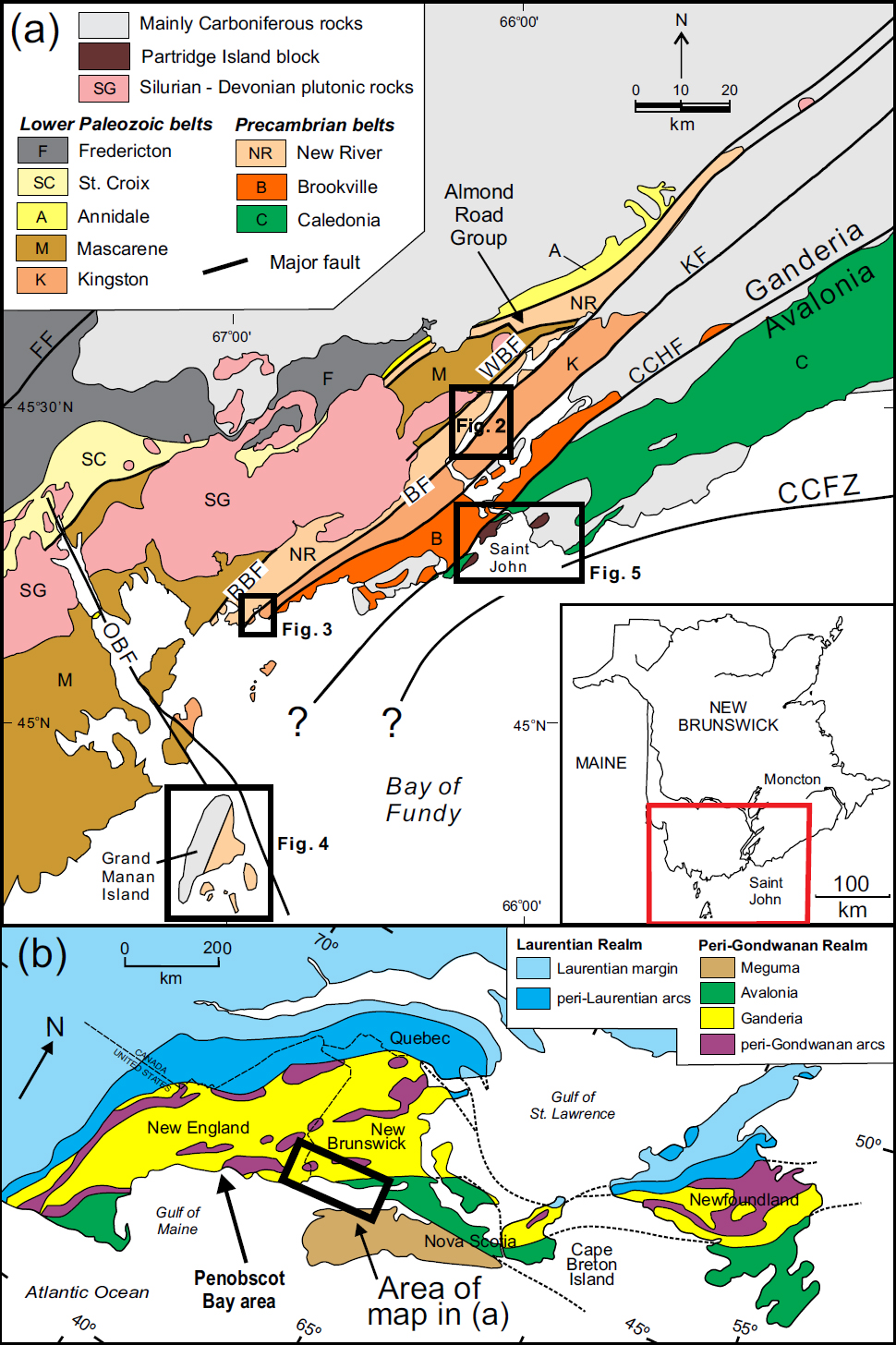 Display large image of Figure 1
Display large image of Figure 1
3 As in other Appalachian detrital zircon studies the interpretations in the present study have to deal with difficulties in interpreting Meso- to Neoproterozoic zircons that could have multiple sources, for example the commonly encountered 1.4 – 1.0 Ga zircon grains which can be derived from any number of long-lived magmatic systems in arcs and continental settings associated with the Grenville orogen in either the West African or Amazonian craton. This difficulty is magnified in syn- and post-collisional strata because of potential contributions from the Laurentian craton with its very large area of Grenville-age magmatic activity. In addition, in Paleozoic samples the Proterozoic signatures are obscured by extensive contributions from syn-accretional and collisional magmatic systems active through the Ordovician to Devonian history of the Appalachian orogen.
4 New LA-ICP-MS detrital zircon age spectra are reported here for six sedimentary and metasedimentary rock units in southern New Brunswick. This study includes samples NB12-314 and NB12-315 of Cambrian age in the New River belt (Figs. 2, 3), one sample GM10-01 of uncertain Precambrian age and two samples NB16-356 and NB16-358 of Neoproterozoic to early Cambrian age from Grand Manan Island (Fig. 4), and sample BL15-01 from the Carboniferous Balls Lake Formation near the city of Saint John (Fig. 5). The new data are compared to previously published data, and in combination, shed light on stratigraphic and terrane relations in the area.
METHODS
5 Detrital zircon U-Th-Pb laser-ablation, inductively coupled plasma mass spectrometry (LA-ICPMS) analyses were conducted at the Texas A&M University R. Ken Williams Radiogenic Isotope Geosciences Laboratory (samples GM10-01, NB12-314, and NB12-315) and the University of New Brunswick (samples BL15-01, NB16-356, and NB16-358).
6 At Texas A&M University, zircon grains were concentrated from rock samples using standard crushing and density separation (jaw and disc crusher, Wilfley table, heavy liquids) methods. Zircon grains were separated from other dense minerals by hand-picking in a petrie dish under a binocular microscope, but no further separation was performed on the bulk zircon aliquot recovered from heavy liquids. The bulk zircon aliquot was piled and quartered repeatedly in the petrie dish to obtain a sub-sample of about 1000 grains. This zircon sub-sample was mounted on double-sided tape and encased in a 2.5 cm diameter epoxy disc, along with fragments of NIST 610, NIST 612, one primary reference material (zircon 91500; Wiedenbeck et al. 1995) and two secondary reference materials (zircons R33 and FC-1; Black et al. 2004 and Paces and Miller 1993, respectively). The disk was abraded with 2000 grit sandpaper to expose the interior of zircon grains and polished to 0.25 µm on a diamond-suspension lap wheel. LA-ICPMS analyses were conducted on a ThermoScientific iCAP RQ quadrupole mass spectrometer running in standard high-sensitivity (STDS) mode connected to an esi/NWR 193 nm 4 ns pulsed excimer laser system equipped with a two-volume sample cell (Tv2). Instrument settings and run parameters are given in Table A1 and analytical data in Table A2. Data are reduced using Iolite v. 3.5 (Paton et al. 2011) under the U–Pb Geochron4 data reduction scheme (Paton et al. 2010). Analysis of the primary reference material, each treated separately as an unknown, indicates an internal analytical reproducibility of U–Pb ages to better than 0.7%. The average accuracy of secondary reference materials (Table A2) is better than 2.25% (FC-1) and better than 1.5% (R33).
7 For the dating done at the University of New Brunswick (UNB), rock samples were sent to Overburden Drilling Management in Ottawa, Ontario, for electro-pulse disaggregation and zircon separation. Zircon grains were then hand-picked at Cape Breton University and taken to UNB where they were mounted in epoxy-covered thin sections polished to expose the centres of the zircon grains and imaged using cold cathodoluminescence to identify internal zoning and inclusions. These images were used to select ablation points (30 µm diameter), avoiding any visible inclusions, cracks, or other imperfections. U and Pb isotopic compositions were measured using the Resonetics S-155-LR 193 nm Excimer laser ablation system connected to an Agilent 7700x quadrupole inductively coupled plasma – mass spectrometer, following the procedure outlined by McFarlane and Luo (2012) and Archibald et al. (2013). Data reduction was done in-house using Iolite software (Paton et al. 2011) to process the laser output into data files, and further reduced for U–Pb geochronology using VizualAge (Petrus and Kamber 2012). Data were sorted by % concordance (206Pb/238U versus 207Pb/235U), and by the % of radiogenic Pb in the grains as calculated using VizualAge (Table A3, A4).
8 In all cases we present probability distribution histograms based on 206Pb/238U dates for grains <1000 Ma and 207Pb/206Pb dates for >1000 Ma, and show all grains that are between 95 and 101% concordant. To determine the youngest age represented in each sample we use only clusters of more than 3 grains with ages that overlap within error and are 98–101% concordant. Using only near-concordant grains that overlap within error is a conservative approach which serves to reduce the possibility of misrepresenting the maximum depositional age as too young by using single grains that may have experienced Pb loss (Dickinson and Gehrels 2010).
9 For each dated sample, the geological setting is described, followed by the results and interpretation. A subsequent Discussion deals with the oveall implications of the new data.
SAMPLE NB12-314 - CHEYNE SETTLEMENT ROAD
Geological setting
10 Quartz arenite sample NB12-314 was collected from an outcrop on Cheyne Settlement Road in the Long Reach area of the New River belt (Fig. 2). Cheyne Settlement Road crosses an enclave of Cambrian rocks, one of several such occurrences in the Long Reach area (Fig. 2). The Cambrian rocks overlie Late Neoproterozoic to early Cambrian volcanic rocks of the Belleisle Bay Group and have been correlated with the Saint John Group (Fig. 2). Matthew (1891) discovered the acrotretid brachiopod Linnarsonnia misera in grey sandstone at Belyeas Landing (now the “Public Landing” shown on Figure 2) about 600 m east of the sampled quartz arenite and Yoon (1970) later discovered trilobites at the same location which he suggested are consistent with a late early Cambrian age, consistent with the work of Boyce and Johnson (2004) based on newly collected material. Small black phosphatic shells tentatively identified as L. misera (R. Miller, personal communication, 2001) were discovered also in a sequence of dark grey shale, siltstone and very fine-grained, micaceous sandstone on Cheyne Settlement Road about 1.2 km west of Public Landing. Johnson (2001) assigned all of the rocks within the enclave, including the quartz arenite unit sampled for dating in the present study, to the Hanford Brook Formation of the Saint John Group (Fig. 2).
11 The dated sample is grey medium-grained quartz arenite. It is dominated by subangular to subrounded quartz grains and less than 10% silt/clay matrix. Feldspar, spherulitic volcanic, and quartzite clasts occur rarely.
 Display large image of Figure 2
Display large image of Figure 2
Results
12 Zircon grains separated from sample NB12-314 display a wide range of sizes, morphologies, and colors. Most grains have abraded corners and edges and are rounded. The largest (~150 um diameter) and most highly rounded grains are also commonly the most deeply colored in shades of pink and purple or tan. Other large (100–150 µm long), more elongate zircon grains show light tan color. Relatively rare, small (50–100 µm long), colorless crystals are acicular with sharp corners and tips.
13 A large percentage of the grains are discordant, and ablation profiles are consistent with Pb-loss being the dominant cause of discordance, as opposed to zircon grains with multiple age components. The main population of grains has ages between 480 and 540 Ma, with only four older grains between 1 and 3.2 Ga (Figs. 6a, b). Three grains have 206Pb/238U ages of ca. 450 Ma but they do not overlap within error and all are less than 98% concordant, our cut-off for calculating concordia ages as mentioned earlier, likely because of Pb loss. In contrast, a few grains have ages between 480 and 500 Ma that overlap within error, and three of these grains produce a calculated concordia age of 487.5 ± 13 Ma with very high MSWD of 15 and probability near zero. Using only two grains produces a calculated concordia age of 485.8 ± 19 Ma with a slightly better MSWD of 10.7 and probability of 0.001. The weighted mean of 7 grains between 475 and 495 Ma is 486.8 ± 6.1 at 95% confidence with MSWD = 2.6, and probability = 0.015 (Fig. 6a, inset). Overall, we consider that the best estimate of the maximum depositional age for the sediment is ca. 487 Ma (late Cambrian to Early Ordovician).
14 This age, although not well constrained, is considerably younger than the age of 508.05 ± 2.75 Ma reported for an ash bed in the Hanford Brook Formation in the Somerset Street section in the city of Saint John (Landing et al. 1998; Schmitz 2012). Based on fossils, the age of the Hanford Brook Formation spans the traditional early to middle Cambrian boundary, or in newer time scales, the boundary between Series 2 and 3 (Palacios et al. 2016) at about 509 Ma (Cohen et al. 2013 updated 2018).
SAMPLE NB12-315 - BUCKMANS CREEK
Geological setting
15 The Buckmans Creek Formation (e.g., Currie 1988) in the Beaver Harbour area of the New River belt (Fig. 3) is an assemblage of fault-bounded and internally faulted sedimentary and mafic volcanic rocks that are in places fossiliferous. They have been correlated with the Saint John Group of the Saint John area (Fig. 5), implying a link between the New River and Caledonia belts (e.g., Currie 1988; Tanoli and Pickerill 1988; Landing 1996; Johnson 2001; Landing et al. 2008). Landing et al. (2008) assigned these Cambrian rocks to the marginal platform of the late Proterozoic to early Paleozoic Avalon microcontinent. They identified the lower Cambrian Chapel Island and Random formations in the Buckmans Creek area, unconformably overlain by mafic volcanic-dominated rocks which Landing et al. (2008) assigned to the “Wade’s Lane Formation”. This name appears to be an incorrect transcription of “Waites Lane” which is shown on road signs in the area and on topographic maps.
16 Landing et al. (2008) reported that the presence of late early Cambrian trilobites and small shelly taxa in the lowest part of their “Wade’s Lane Formation” demonstrates a hiatus between rocks that they assigned to the Random Formation and those of their “Wade’s Lane Formation”. They interpreted the volcanic rocks in the Beaver Harbour section as the result of latest early to middle middle Cambrian pyroclastic volcanism, one of three known volcanic centers that extended 550 km along the northwest margin of the Avalon micro-continent. According to Landing et al. (2008), the volcanic rocks are overlain by grey-green mudstone and limestone of the Fossil Brook Member and black mudstone of the upper Manuels River Formation. However, given the uncertainty of long-distance correlations in a complex orogen, we continue to use the earlier established name Buckmans Creek Formation collectively for all these rocks.
17 Near the mouth of Buckmans Creek, the formation is separated from the plutonic rocks of the Beaver Harbour porphyry by a reverse dip-slip fault (Bartsch 2005). The Beaver Harbour porphyry yielded a U–Pb zircon age of 551 ± 1.2 Ma (Barr et al. 2014a). On its northwestern margin, the formation is in faulted contact with the ca. 620 Ma Blacks Harbour granite (Barr et al. 2003b; Bartsch 2005).
18 Dated quartz arenite sample NB12-315 is from the unit assigned to the Random Formation by Landing et al. (2008). The sample is light grey and consists of recrystallized quartz grains that are sutured and polygonal in places. It contains rare felsic volcanic and quartzite clasts, and almost no matrix.
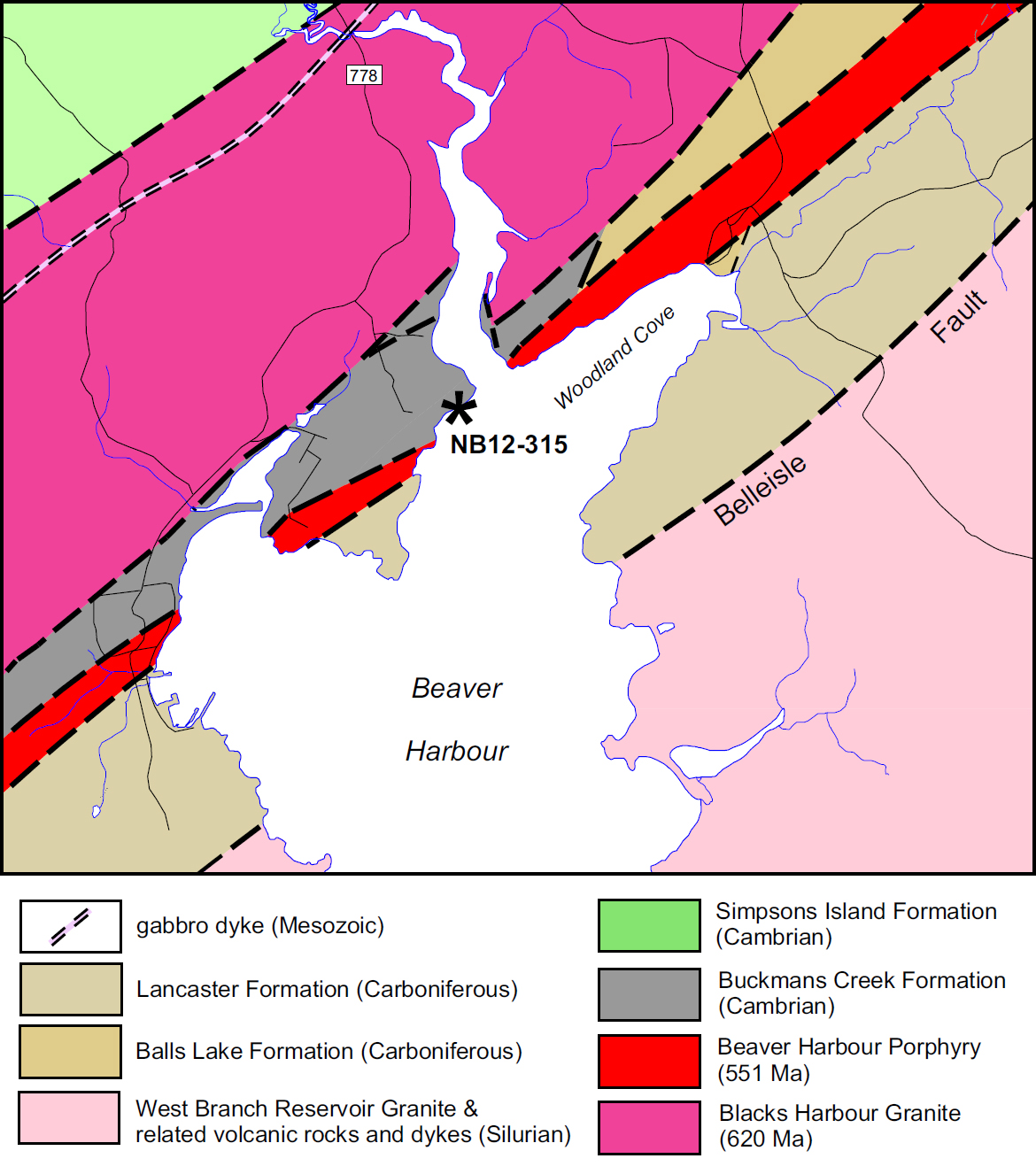 Display large image of Figure 3
Display large image of Figure 3
Results
19 A total of 203 zircon grains were analyzed from sample NB12-315. The main population has ages from 510 to 590 Ma (Figs. 6c, d). Other grains give an almost continuous range of ages from 1 Ga to 2 Ga and a few grains lie between 2 and 3.2 Ga. The youngest 4 grains that overlap within error have a calculated concordia age of 518.4 ± 2.8 Ma with MSWD = 6.7 and probability = 0.010. The calculated concordia age with 5 overlapping grains including one that is more discordant is 518.3 ± 4.7 Ma with much higher MSWD of 12.0 and lower probability of 0.001. The weighted mean of the same 5 grains is 517.2 ± 2.7 at 95% confidence with MSWD = 0.41 and probability = 0.80 (Fig. 6c, inset). Hence the maximum depositional age for this sample is interpreted to be ca. 517 Ma (Cambrian series 2; Cohen et al. 2013, revised 2018).
SAMPLE GM10-01 - THE THOROUGHFARE FORMATION
Geological setting
20 The Thoroughfare Formation of Grand Manan Island is exposed on Ross, Nantucket, and White Head islands off the southeastern coast (Fig. 4). It is composed of very thick- to thin-bedded, locally cross-bedded, white to light grey quartzite interbedded with grey to black carbonaceous shale. Where exposed on the western shore of The Thoroughfare, the contacts between the formation and volcanic sequences of the Priest Cove Formation are highly sheared and interpreted as thrust faults based on the presence of low-angle cleavages in the vicinity of their mutual boundaries (Fyffe 2014). The inferred age of The Thoroughfare Formation is late Proterozoic as suggested by Alcock (1948) who correlated the quartzite with quartzite interstratified with platformal stromatolitic carbonates of the Late Proterozoic Green Head Group in the Saint John area on the New Brunswick mainland, although the latter unit does not include carbonaceous shale and The Thoroughfare Formation lacks carbonate rocks, so the only rock type in common is the quartzite itself. The Thoroughfare Formation could be correlative with the Hutchins Island Quartzite in Penobscot Bay, Maine (Fig. 1b) which also has an inferred late Proterozoic age (Reusch et al. 2018).
21 The dated quartzite sample consists of recrystallized quartz grains that are rectangular and elongate parallel to a weak foliation. Granular quartz around the larger grains suggests that brittle deformation may have overprinted earlier ductile structures. Rare muscovite and tourmaline are also present.
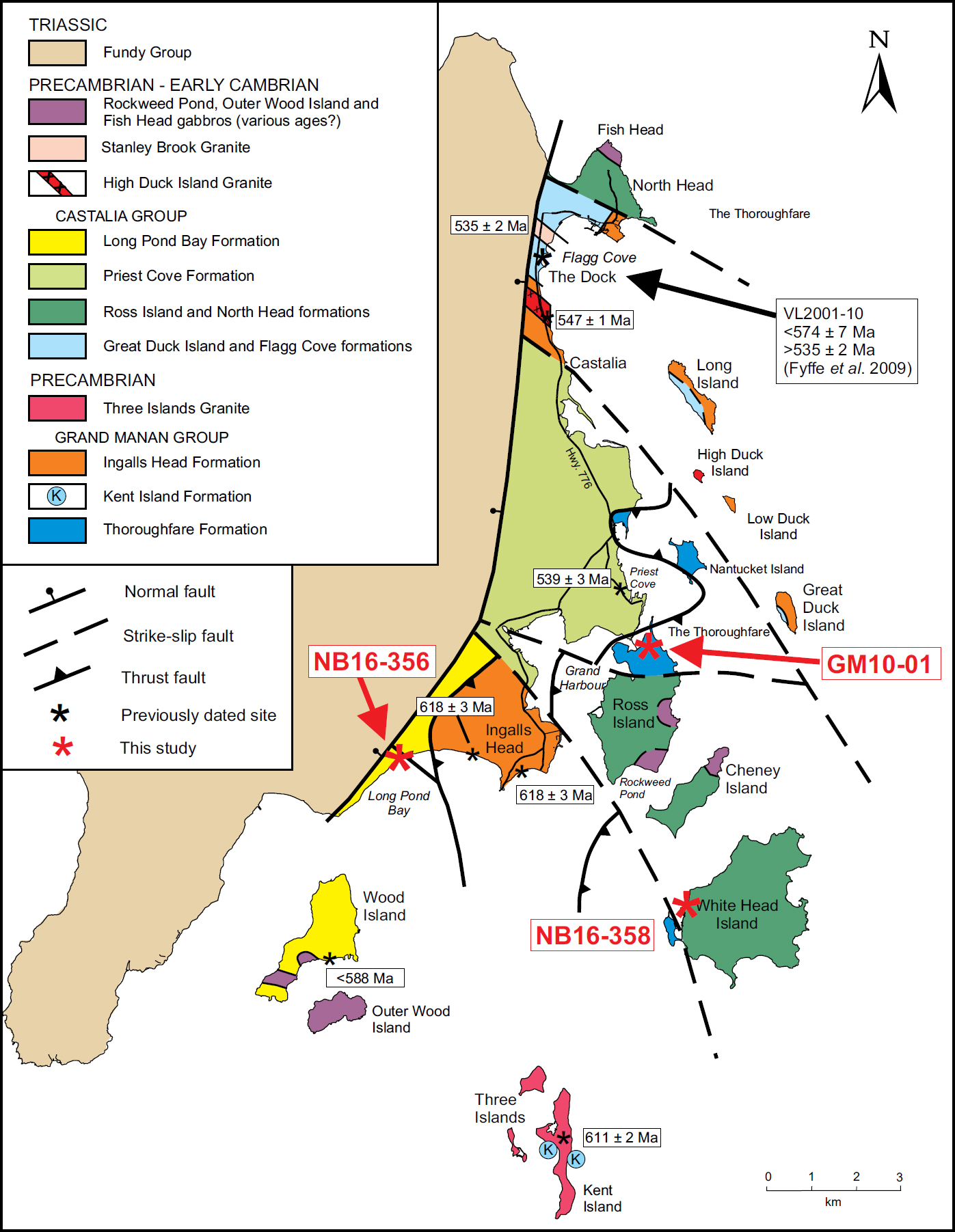 Display large image of Figure 4
Display large image of Figure 4
Results
22 Sample GM10-01 is distinctive in that it contains only Paleoproterozoic and older zircon grains that are much older than the inferred Late Proterozoic stratigraphic age. Its detrital signature is unlike any others yet seen in New Brunswick, including the nearby Flagg Cove Formation (Fig. 3; Fyffe et al. 2009), but like those from samples from Georges Bank and Penobscot Bay inferred to represent sediments deposited on the West African Craton (Kuiper et al. 2017; Reusch et al. 2018). The biggest population of zircon grains has ages between 1.9 and 2.2 Ga, with another significant peak at ca. 2.5, and an almost continuous range of ages from 2.5 to 3.2 Ga (Fig. 6e). The youngest two grains are around 1.65 Ga, but they do not overlap within error and cannot be used for a concordia age. Based on these youngest grains the maximum depositional age of the sample may be less than 1.65 Ga but this estimate is not robust. The maximum depositional age based on the detrital zircon populations is better constrained at 1.9 Ga based on the major population peaks.
SAMPLE NB16-356 - LONG POND BAY FORMATION
Geological setting
23 The Long Pond Bay Formation is exposed along Long Pond Bay and on nearby Wood Island on southern Grand Manan Island (Fig. 4). The Long Pond Bay shoreline section consists of subaqueous hyaloclastic basalt flows, mafic volcanic breccia, peperitic basalt, green cherty mudstone, and medium- to thick-bedded wacke. On Wood and adjacent islands, amygdaloidal basalt flows, felsic tuff, and arkosic sandstone appear to have been deposited in shallower water and are associated with coarse-grained gabbroic rocks (Fig. 4). A sample from a rhyolitic tuff or high-level intrusion from Wood Island yielded few zircon grains that were interpreted by Miller et al. (2007) to indicate a maximum depositional age of ca. 588 Ma. The relatively undeformed features of the unit and its lithological similarities to Silurian units of the Mascarene terrane on the mainland (McLeod et al. 1994) led to the assumption of a Silurian age (Miller et al. 2007). However, Fyffe (2014) subsequently interpreted the Long Pond Bay Formation to be part of the Ediacaran–Cambrian Castalia Group, together with the Priest Cove Formation dated at 539 ± 3 Ma by Miller et al. (2007). Fyffe (2014) correlated the Long Pond Bay Formation with the Simpsons Island Formation in the New River terrane on the mainland which also yielded an age of 539 ± 4 Ma (Barr et al. 2003b).
24 Dated sample NB16-356 is from a grey sandstone unit in the Long Pond Bay shoreline section (Fig. 4). It is immature and matrix-supported and consists of angular quartz and less abundant plagioclase grains in a fine matrix of clay (sericite) and silt. Detrital muscovite and biotite altered to chlorite are also present.
Results
25 In this sample only 64 out of 145 grains are between 95 and 101% concordant and a further 22 grains are between 90 and 95% concordant. The largest population of zircon grains in sample NB16-356 is in the range between 690 and 600 Ma, with minor populations at around ca. 790 Ma, 1.1–1.2 Ga, and a few grains between 1.5–2 Ga (Figs. 7a, b). The concordia age of the youngest three grains that overlap is 614.6 ± 6.1 Ma with MSWD = 5.7 and probability (of concordance) = 0.017. The weighted mean of the youngest 6 grains that overlap within error is 614.7 ± 4.6 at 95% confidence with MSWD = 0.67 and probability = 0.64 (Fig. 7a, inset). The interpreted maximum depositional age for this sample is therefore < 614 Ma. This result does not tighten the limited constraints on the depositional age of the Long Pond Bay Formation, previously suggested to be <588 Ma (Miller et al. 2007). However, the similarity of the dates from the youngest detrital grains to the U–Pb (zircon) ages of 617.6 ± 3.2 Ma and 618.3 ± 2.8 Ma for two tuffaceous samples from separate locations in the nearby Ingalls Head Formation (Fig. 4) suggest that the Ingalls Head Formation was the source of the detrital grains. The result is consistent with the inclusion of the Long Pond Bay Formation in the upper part of the Neoproterozoic to Lower Cambrian Castalia Group (Fyffe 2014).
SAMPLE NB16-358 - ROSS ISLAND FORMATION
Geological setting
26 The Ross Island Formation underlies the greater part of Ross and White Head islands near the southeastern coast of Grand Manan (Fig. 4). It comprises interstratified plagioclase-phyric mafic and intermediate flows and breccias intruded by numerous diabase dykes. The flows are locally pillowed and interbedded with green laminated siltstone. They range from basalt to andesite based on chemical composition, and are calc-alkalic, formed in a volcanic arc setting (Hilyard 1992; Hewitt 1993; Hodgins 1994; Pe-Piper and Wolde 2000; Black 2005). The Ross Island Formation appears to be truncated by faults that separate it from quartzite of The Thoroughare Formation on the northern tip of Ross Island and western tip of White Head Island (Fig. 4). The formation had no previous age constraints but was assumed to be part of the Precambrian to early Cambrian Castalia Group (Fyffe 2014).
27 Dated sample NB16-358 is dark grey laminated siltstone that occurs in peperitic relationship with basalt near the ferry terminal on the western shore of White Head Island. The sample is fine-grained and contains abundant plagioclase. Its swirly matrix contains abundant sericite and has an ash-like appearance.
Results
28 NB16-358 is very poor in zircon and only had 25 grains analyzed, 20 of which are betwee 95 and 101% concordant. The largest populations of zircon grains are in the range between ca. 580 Ma and 630 Ma, with a small group at ca. 700 Ma, and a few grains between 1 and 2 Ga (Figs. 7c, d). A single grain at ca. 320 Ma is not considered to be a reliable indicator of maximum depositional age. The concordia age of the youngest three grains that overlap is 585.5 ± 8.4 Ma with MSWD = 2.6 and a probability (of concordance) = 0.11. The weighted mean of the same four grains is 580 ± 11 at 95% confidence with MSWD = 0.26, and probability = 0.86. Based on these data, the maximum depositional age for this sample is interpreted to be ca. 580 Ma, similar to that of the Long Pond Bay Formation as determined by Miller et al. (2007). This age is consistent with the suggestion by Fyffe (2014) that the volcanic rocks of the Ross Island Formation represent a proximal facies of the Priest Cove Formation.
SAMPLE BL15-01 - BALLS LAKE FORMATION
Geological setting
29 The Balls Lake Formation is a coarse clastic sedimentary unit in the Saint John area that is interpreted currently as the lower unit of the Upper Carboniferous Cumberland Group (Fig. 5). However, traditionally it was included in the Mispec Group as the middle formation, underlain by basaltic and sedimentary rocks of the West Beach Formation and overlain by plant-bearing lithic arenite of the Lancaster Formation. The sequence was considered conformable and the entire group regarded as Mississippian(?) to Pennsylvanian or Pennsylvanian based on plant remains in the Lancaster Formation (e.g., Hayes and Howell 1937; Alcock 1938). Plint and van der Poll (1982) reassigned the Balls Lake and Lancaster formations to the Cumberland Group and Park et al. (2014) showed that the West Beach Formation and the laterally correlative(?) Taylors Island Formation are part of the allochthonous Partridge Island block and not part of the stratigaphy of the Cumberland Group (Fig. 5). In the Calvert Lake area southeast of Saint John, rocks of the Partridge Island block are contained in a klippe, preserved in a synform in the Balls Lake Formation that plunges gently west-southwest. The conglomerate–sandstone–mudstone sequence of the surrounding Balls Lake Formation is overturned to the south in the footwall of the Calvert Lake klippe along its southern contact, consistent with thrust transport toward the south-southeast. The Balls Lake Formation has no direct biostratigraphic controls on its age.
30 The dated sample is typical reddish-grey sandstone from the Balls Lake Formation in the overturned section on Bayshore Drive. It contains subangular quartz and plagioclase in a sericitic matrix that contain abundant carbonate cement. The quartz grains are angular to subangular and varied in size and shape. Detrital muscovite and opaque phases are abundant.
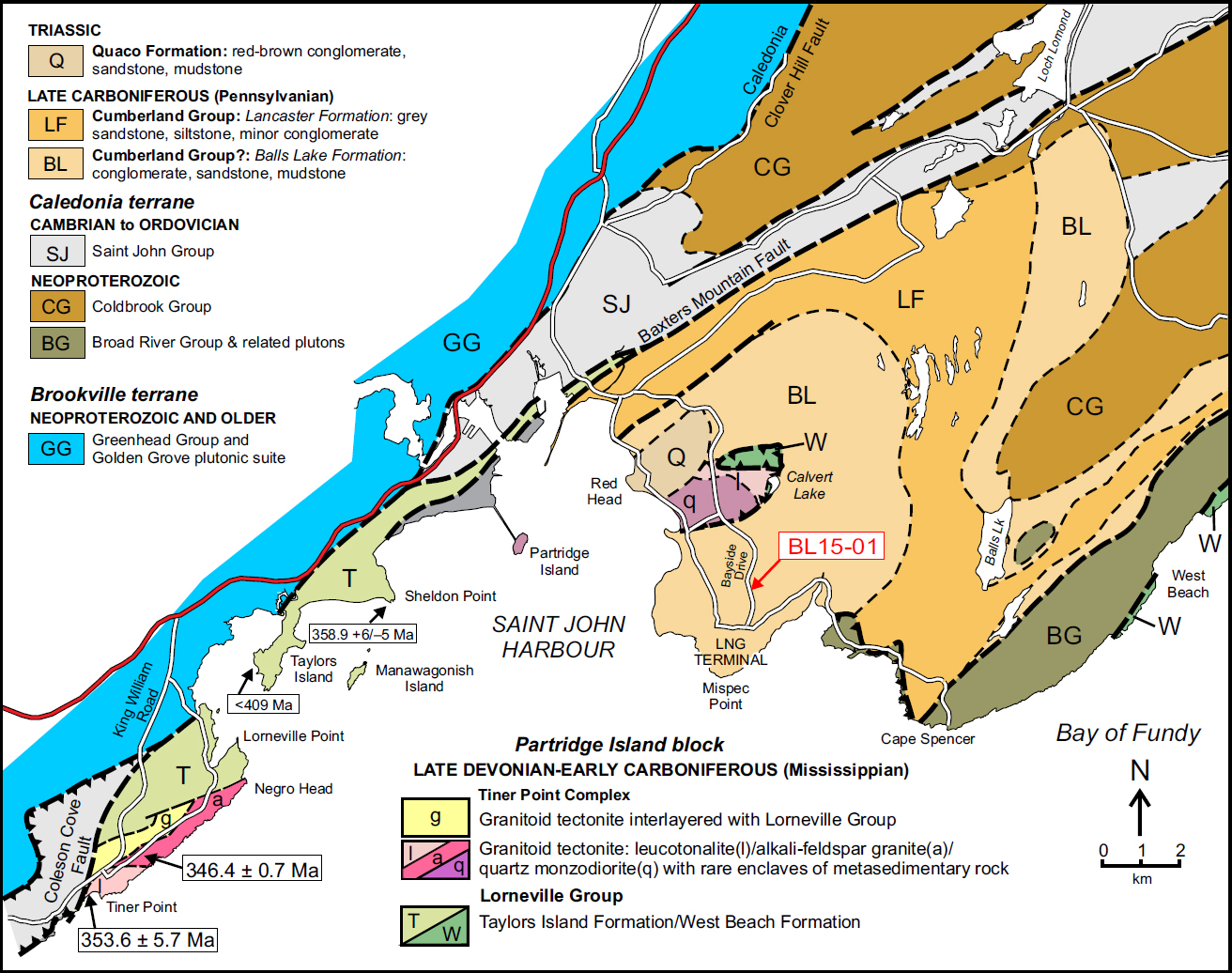 Display large image of Figure 5
Display large image of Figure 5
Results
31 The largest populations of zircon grains in sample BL15-01 are in the range between ca. 430 and 390 Ma (Figs. 7e, f). Smaller groups of ages occur at ca. 550 Ma, 600 Ma and 1 Ga, with a few older grains between 1 Ga and 2 Ga. The youngest 5 grains that overlap within error have a calculated concordia age of 397.3 ± 1.9 Ma with MSWD= 5.0, and probability (of concordance) = 0.025. The weighted mean of the same 5 grains is 396.5 ± 1.9 Ma at 95% confidence with MSWD = 0.78 and probability = 0.54 (Fig. 7e, inset). Based on these data, the maximum depositional age for this sample is interpreted to be ca. 396 Ma, much older than the inferred Late Carboniferous depositional age for the formation based on field relationships. The lack of Late Devonian– Early Carboniferous ages indicates that the Partridge Island block, which contains volcanic and plutonic rocks of that age, was not providing debris to this unit of the Balls Lake Formation. The Middle Devonian – Silurian zircon grains in the sample could have been derived from any number of plutonic suites both locally and farther afield.
DISCUSSION
Depositional ages
32 The depositional ages of all six samples included in this study are equivocal based on other evidence, and hence the maximum depositional ages described above based on the youngest zircon populations are potentially important. However, as in all detrital zircon studies, the data are viewed in combination with field and other evidence because of the potential for Pb loss which can move zircon ages to younger points along concordia (e.g., Dickinson and Gehrels 2010), as well as the possibility of inclusion of second-cycle detritus or lack of zircon sources close in age to the deposition of sediment. However, even with these caveats in mind, the detrital zircon U–Pb data provide valuable information about sedimentary provenance and maximum depositional ages. The samples are discussed here in reverse age order.
33 The Silurian and younger populations present in sample BL15-01 from the Balls Lake Formation include prominent populations of Early and Middle Devonian zircon grains but no younger grains, although the depositional age of the Balls Lake Formation is Carboniferous based on stratigraphic and field relationships (e.g., Park et al. 2014). A similar pattern of Carboniferous units with Devonian zircon grains as their youngest populations was found in a study in the southern Appalachian orogen by Thomas et al. (2017) in which several Pennsylvanian units contain significant Devonian zircon populations but no younger grains. These well-documented examples are a reminder that “maximum deposition ages” provide only an upper limit on stratigraphic age. Pre-Devonian zircon grains are sparse in sample BL15-01 (Figs. 7e, f) and could be evidence for either Gondwanan or Laurentian source areas but could also represent recycled detrital material from multiple sources.
34 Cheyne Settlement Road sample NB12-314 contains a significant Cambrian zircon population with a maximum depositional age of ca. 487 Ma and, therefore, latest Cambrian or younger (Figs. 6a, b). This maximum age is younger than the broadly “middle Cambrian” age generally assigned to the Hanford Brook Formation based on fossils and a U–Pb zircon date of 508.05 ± 2.75 Ma from an ash bed in the city of Saint John (Landing et al. 1998; Schmitz 2012). Although more work needs to be done in order to investigate this apparent age enigma, it is possible that the Cheyne Settlement Formation is correlative instead with the Snider Mountain Formation in the Almond Road Group which occurs in the New River belt to the northeast (Fig. 1a). The youngest zircon population in quartz arenite in the Snider Mountain Formation is ca. 530 Ma, and the age of the upper sequence that contains feldspathic quartz arenite near its base is constrained by a cross-cutting pluton that gave an age of 475.4 ± 1.6 Ma (Johnson et al. 2018). It is possible that the Cheyne Settlement sample exemplifies the gradual younging of quart arenite deposition within the same unit outward from the platform during protracted rifting and opening of the ocean basin along the Gondwanan margin as illustrated by Johnson et al. (2018).
35 The sample from Buckmans Creek (Fig. 3) also has a significant Cambrian zircon population but the youngest population (maximum depoisitional age) is older at ca. 517 Ma (Cambrian series 2). Landing et al. (2008) interpreted the dated quartz arenite unit at Buckmans Creek to be part of the Random Formation. The age of that formation in the Saint John area (where it is historically known as the Glen Falls Formation) is constrained by volcanic ash beds with ages of ca. 528 Ma in the underlying Ratcliffe Brook Formation and ca. 508 Ma in the overlying Hanford Brook Formation. Hence the maximum depositional age of 517 Ma for sample NB12-315 is consistent with these age constraints.
36 In contrast to these early Paleozoic samples, the samples from the Long Pond Bay and Ross Island formations (Figs. 7a–d) do not have Cambrian or younger zircon grains and hence their maximum depositional ages based on zircon data alone appear to be Neoproterozoic. The data are broadly consistent with previous interpretations of these units as Neoproterozoic but do not narrow down the depositional age greatly, especially for the Long Pond Bay Formation, due to the small number of zircon grains that yielded concordant results. However, the results are consistent with the interpretations of Fyffe (2014) who included the Long Pond Bay Formation in the upper part of the Neoproterozoic to Lower Cambrian Castalia Group and suggested that the volcanic rocks of the Ross Island Formation are a proximal facies of the Priest Cove Formation of the Castalia Group (Fig. 4).
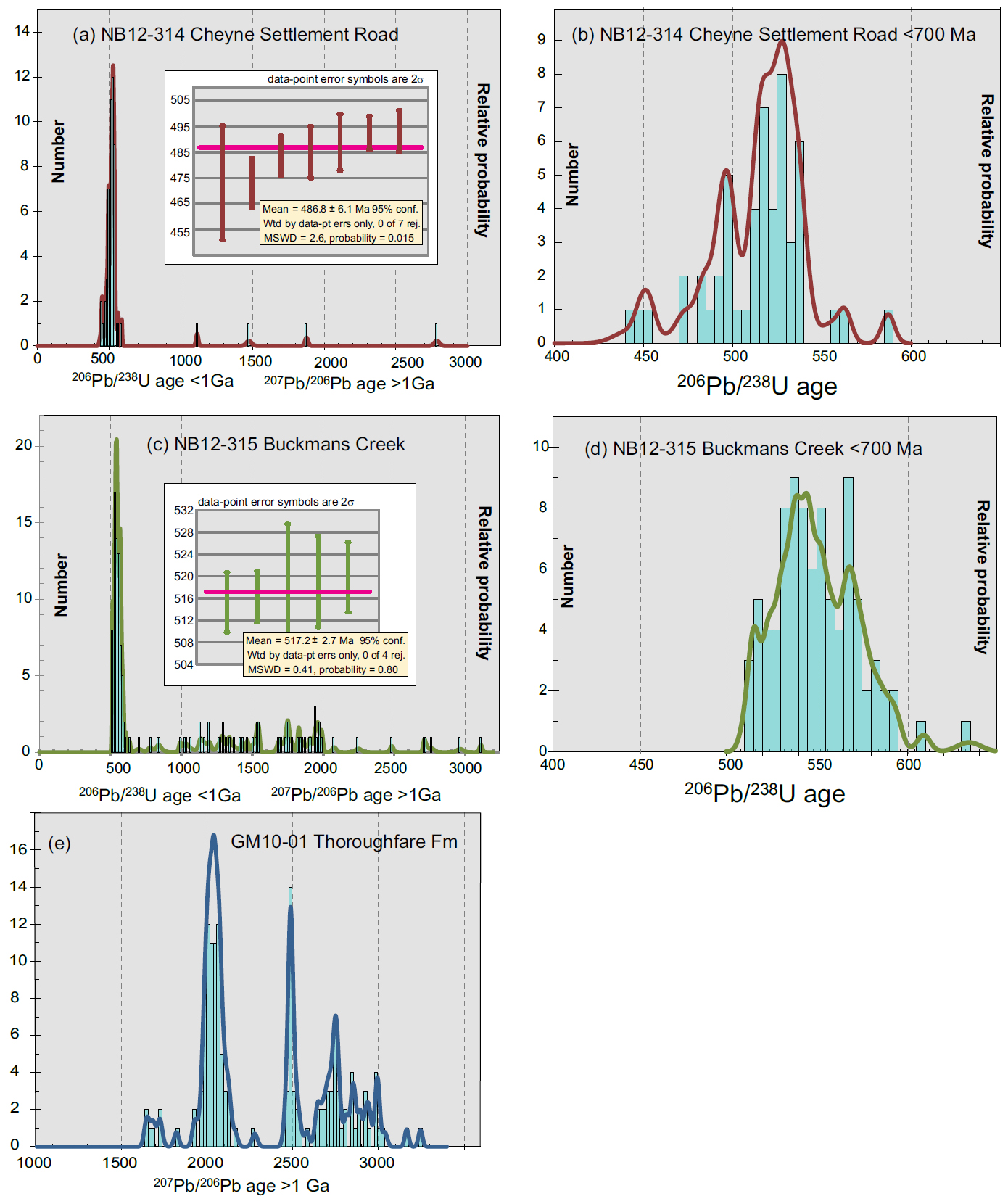 Display large image of Figure 6
Display large image of Figure 6
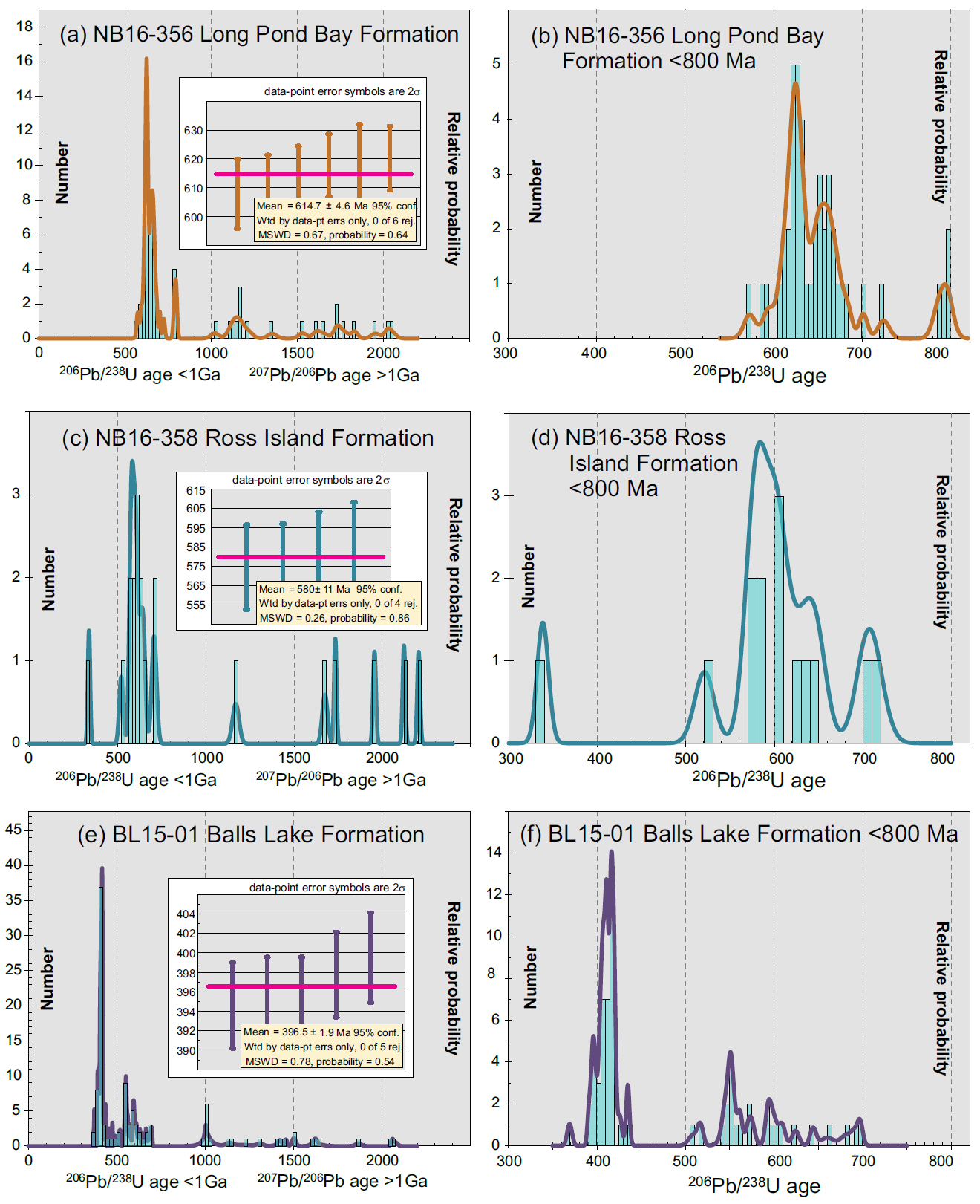 Display large image of Figure 7
Display large image of Figure 7
Provenance implications
37 To facilitate comparison of datasets of various sizes, data from the present study together with previously published detrital age data for samples from Avalonia and Ganderia in southern New Brunswick are displayed on probability plots normalized for the number of dates (Figs. 8, 9). Because older grains are typically much less abundant than Ediacaran grains and hence tend to be produce less prominent peaks on the probability plots (Fig. 8), the normalized plots in Figure 9 were made using only dates older than 900 Ma. Except for three samples (NB06-232, NB12-314, and NB16-358) in which the number of grains with dates >900 Ma is small (<10), the data give reasonable signatures for comparison of Mesoproterozoic and older zircon signatures among samples (Fig. 9).
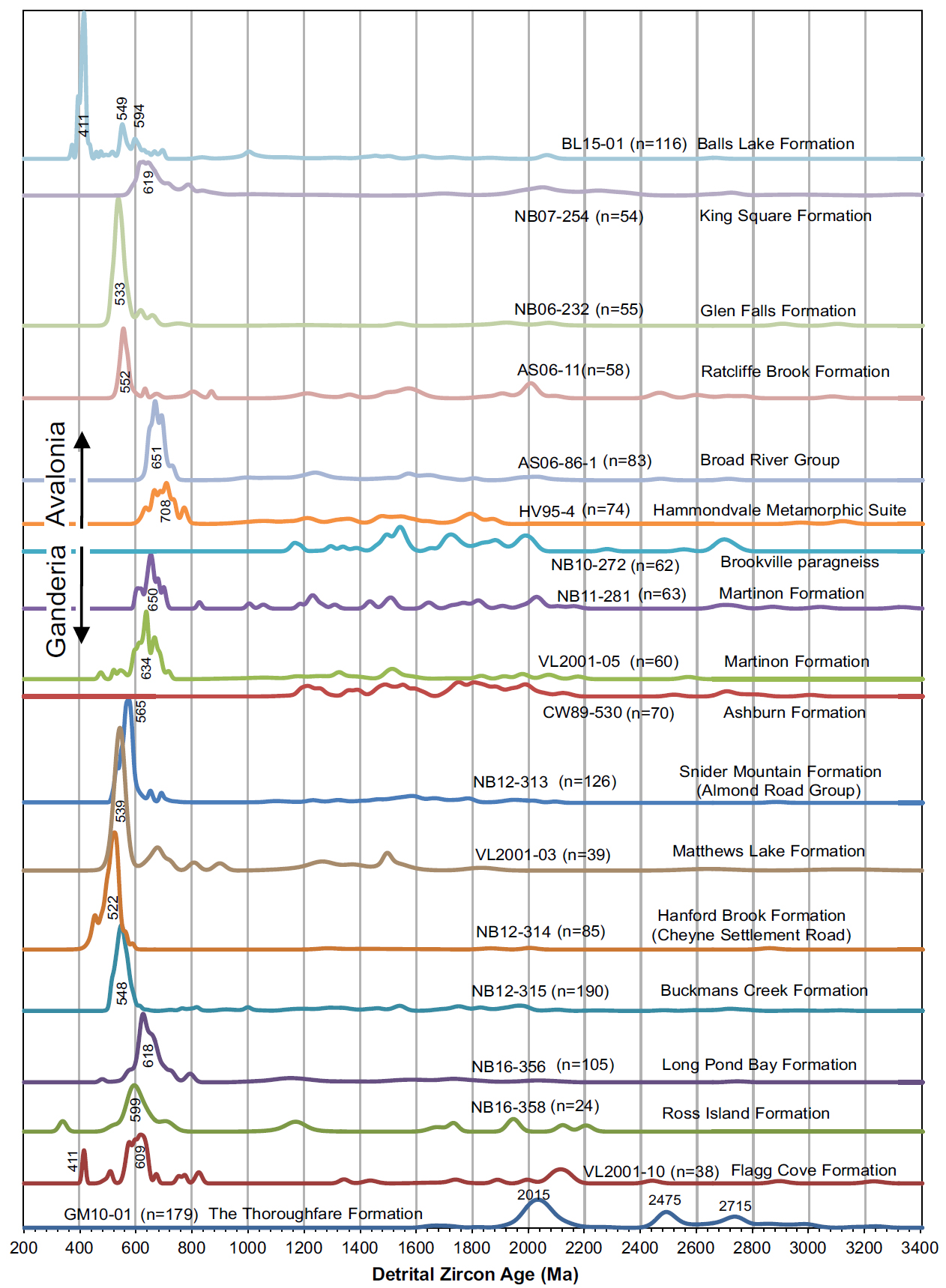 Display large image of Figure 8
Display large image of Figure 8
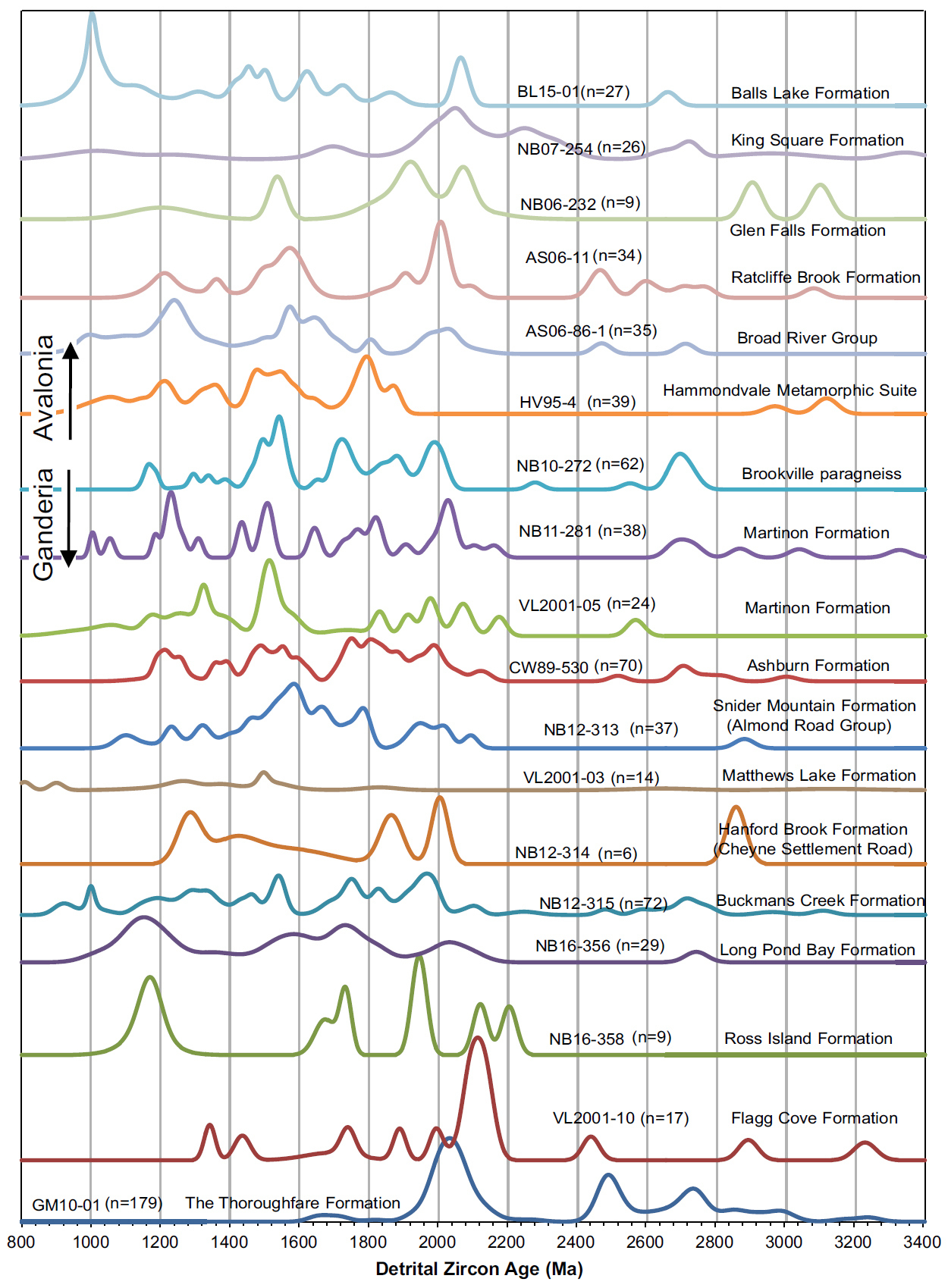 Display large image of Figure 9
Display large image of Figure 9
38 With the exception of sample GM10-01 from The Thoroughfare Formation, all of the samples are characterized by prominent Ediacaran peaks in zircon ages (Fig. 8). Such peaks are characteristic of sedimentary rocks from Gondwana-derived terranes and reflect the widespread pan-African igneous activity related to the assembly of the Gondwanan continent (e.g., Satkoski et al. 2010; Pollock et al. 2009, 2015; Dokken et al. 2018; Ludman et al. 2018). It is difficult to assess the significance of the variations in the position of the Ediacaran peak or of the spread in Ediacaran ages in terms of specific provenance areas in Gondwana because even samples from a single belt or stratigraphic unit can display significant differences, as has been documented in the Ganderian parts of New Brunswick, Nova Scotia, and Newfoundland (e.g., Fyffe et al. 2009; Satkoski et al. 2010; Barr et al. 2012; van Rooyen et al. 2019).
39 In addition to the Ediacaran peak somewhere between 539 Ma and 619 Ma, most samples show a scatter of older Neoproterozoic ages back to about 900 Ma, although such older Neoproterozoic ages are notably absent in the Cheyne Settlement Road sample (Fig. 8). In general, Grenville-age (1.0–1.2 Ga) peaks are not present in the samples of this study or those compiled from previous studies (Fig. 9), indicating that Laurentian sources were not significant contributors to these sediments. Also lacking in most samples are prominent “Eburnean” (2.0 –2.2 Ga) peaks, generally considered indicative of African sources. Exceptions include the sample from The Thoroughfare Formation on Grand Manan Island, in which that peak is dominant, and the sample from the nearby Flagg Cove Formation (data from Fyffe et al. 2009) which likely derived sediment from The Thoroughfare Formation or equivalent units. In general, Ganderian samples have more abundant Mesoproterozoic peaks than Avalonian samples, a pattern that is generally viewed as indicating Amazonian provenance (e.g., Barr et al. 2014b) but all of the Avalonian samples have some Mesoproterozoic peaks and some Ganderian samples, especially those from Grand Manan Island, have relatively few Mesoproterozoic peaks (Fig. 9).
40 The interpretation of Mesoproterozoic zircon provenance is challenging as illustrated in the Fredericton trough in New Brunswick and Maine northwest of the study area. Although the Fredericton trough is farther outboard of the Gondwanan margin within Ganderia than the current study areas (Fig. 1a), it provides a comparison dataset for areas to the southeast. Ludman et al. (2017, 2018) suggested that the Fredericton trough represents an independent basin that was not linked to the more southern New England basins, and interpreted the detrital zircon signatures as being derived from dominantly Gondwanan sources. In contrast, Dokken et al. (2018) documented more mixed zircon provenance signature with significant Laurentian contributions. The differences in detrital zircon signatures are likely the result of along-strike variations in the source terranes, and support interpretations that Ganderia may have been a collection of continental fragments that accreted to the Laurentian margin at different times rather than forming one coherent crustal block (Waldron et al. 2014, 2018, 2019; Pothier et al. 2015).
41 In Avalonia, Barr et al. (2012) noted a change in the provenance of detrital zircon grains through time, Neoproterozoic units being characterized by lack of zircon grains with ages between 2.2 and 1.9 Ga, with the exception of a small peak at 2.0 Ga in the Neoproterozoic Broad River Group in the Caledonia belt (Fig. 9). By the early Cambrian zircon grains of this age are more abundant. Fyffe et al. (2009) noted a similar trend in Neoproterozoic to Tremadocian sedimentary units in Ganderia, with 2.2 to 1.9 Ga ages becoming much more abundant overall in Cambrian– Ordovician samples. However, exceptions to the trend occur in Cambrian samples from both Ganderia and Avalonia. For example, a quartz arenite sample from the lower Cambrian Glen Falls Formation (Random Formation of Landing and Westrop 1998) in the Avalonian Caledonia belt (Fig. 8) contains few zircon grains ages between 2.2 to 1.9 Ga, and the dominant age population is ca. 537 Ma (Barr et al. 2012). The quartzite sample from the early Cambrian Matthews Lake Formation in the Ganderian New River belt (Fig. 8) also lacks zircon grains with ages between 2.2 and 1.9 Ga and is dominated by a single statistical age population at 539 Ma (Fyffe et al. 2009). The abundant volcanic rocks in the ca. 540 Ma Belleisle Bay Group in the New River belt are the most obvious source of the ca. 539 Ma zircon grains in the Matthews Lake quartzite, and along with the voluminous ca. 540 Ma plutonic rocks in the Brookville belt are the closest possible sources for the ca. 537 Ma zircons in the Glen Falls Formation, although 40Ar/39Ar cooling ages show that the Brookville plutons were not exposed at the time when the Glen Falls Formation was deposited (Dallmeyer and Nance 1992; White 1996).
42 The absence of Mesoproterozoic and Neoproterozoic zircon grains in the quartzite samples from The Thoroughfare Formation is intriguing. Grains of those ages form the dominant populations in every other sample in this study, and in every other sedimentary sample from the region (Fig. 8). It is one of only 3 northern Appalachian samples known to have this type of signature, one from drill core recovered from Georges Bank, underlying Mesozoic sedimentary rocks (Kuiper et al. 2017) and the other from the Hutchins Island Quartzite in the Islesboro fault block in Penobscot Bay in coastal Maine (Reusch et al. 2018). As noted by Kuiper et al. (2017) and Reusch et al. (2018) these detrital signatures, with a predominant population at ca. 2.0 Ga and a small peak between ca. 2.8 Ga and 2.4 Ga, are remarkably similar to that of the Paleoproterozoic Taghdout Quartzite in Morocco on the West African craton. Similar peaks are also present in the spectrum for the Flagg Cove Formation reported by Fyffe et al. (2009), although that sample also contains abundant Mesoproterozoic, Neoproterozoic, and Paleozoic grains. Given its proximity, The Thoroughfare Formation seems the most likely source of the Paleoproterozic grains in the Flagg Cove Formation. The detrital spectrum is very different from that of the Ashburn Formation of the Green Head Group in the Brookville belt, which like other units of that belt (Martinon Formation and Brookville paragneiss) are dominated by Mesoproterozoic zircon grains (Fig. 8). This calls into question the previous correlation (e.g., Alcock 1948) of The Thoroughfare Formation with the Green Head Group and suggests that correlation with the Isleboro fault block in Penobscot Bay may be more likely.
CONCLUSIONS
43 New U–Pb data from detrital zircon grains in six clastic sedimentary and metasedimentary samples from Ganderian and Avalonian terranes in southern New Brunswick show both similarities and differences in Ediacaran and older age patterns. Like previously published data from southern New Brunswick, four of the samples (BL15-01, NB12-315, NB16-356, NB16-358) have prominent Late Ediacaran to earliest Cambrian zircon age populations, but the position of the modal peak varies from ca. 548 Ma to 618 Ma. The fifth sample (NB12-314) has an early Cambrian peak at ca. 522 Ma, and the sixth sample (GM10-01) has only Paleoproterozoic peaks (Fig. 8). Some samples show a smattering of ages back to ca. 800, but generally lack 800–1200 Ma zircon grains. The samples vary widely in their abundances of older Mesoproterozoic and Paleoproterozoic grains, and a few Archean zircon grains are present in some samples. No consistent differences are apparent between Avalonian and Ganderian samples. Because Gondwanan sources areas contain a wide range of ages which are broadly similar, combined with the many variables inherent in sediment erosion, transport, deposition, and recycling, the use of detrital zircon age signatures to interpret from which part of Gondwana the Gondwana-derived components of the Appalachian orogen were derived may not be possible.
We thank Adrian Park for collecting the sample from the Balls Lake Formation. We are grateful to Brandon Boucher and Chris McFarlane for assisting Deanne van Rooyen with the U–Pb dating at the University of New Brunswick and for providing invaluable advice in processing and interpreting the age data. Brent Miller thanks the laboratory staff at Texas A&M University for their help. Comments and suggestions by journal reviewers Les Fyffe and John Waldron were helpful in improving the content and clarity of the manuscript and are much appreciated. This work was fund-ed mainly through research agreements between the Geo-logical Surveys Branch of the New Brunswick Department of Energy and Mines/Department of Energy and Resource Development and Acadia University and NSERC Discovery grants to Sandra Barr.
APPENDIX
Table A1.
 Display large image of Table 1
Display large image of Table 1
Table A2.
 Display large image of Table 2
Display large image of Table 2
- U–Th–Pb concentrations referenced to either NIST 612 glass or 91500 zircon; concentration uncertainty approximately ± 20%.
- Isotope ratios not corrected for common Pb.
- Dates calculated with decay constants of Jaffey et al. (1971) and 238U/235U = 137.818 (Hiess et al. 2012) using Iolite v. 3.5 (Paton et al. 2011) and U–Pb Geochron4 DRS (Paton et al. 2010). Preferred dates used in plots are 206/238 dates less than 700Ma and 207/206 dates greater than 700 Ma.
- Discordance calculated as (1-(206Pb/238U age / 207Pb/235U age))*100.
- Concentration data are means of all anlayses; dates and isotope ratios are weighted means of all analyses <2% discordant. Average reproducibility of individual U–Pb dates from primary reference material is better than 0.7% (reduced separately as unknowns) and average accuracy of secondary reference material is 1.5% or better.
Table A3.
 Display large image of Table 3
Display large image of Table 3
- after Hg correction
- in counts per second
- radiogenic
- Correction factor: 1 = threshold 204Pb cps for no correction (80 cps); 2 = threshold % for 204Pb-based correction (21 %error); 3 = threshold % for 208Pb-basedcorrection (98.5 % radiogenic Pb)
Table A4.
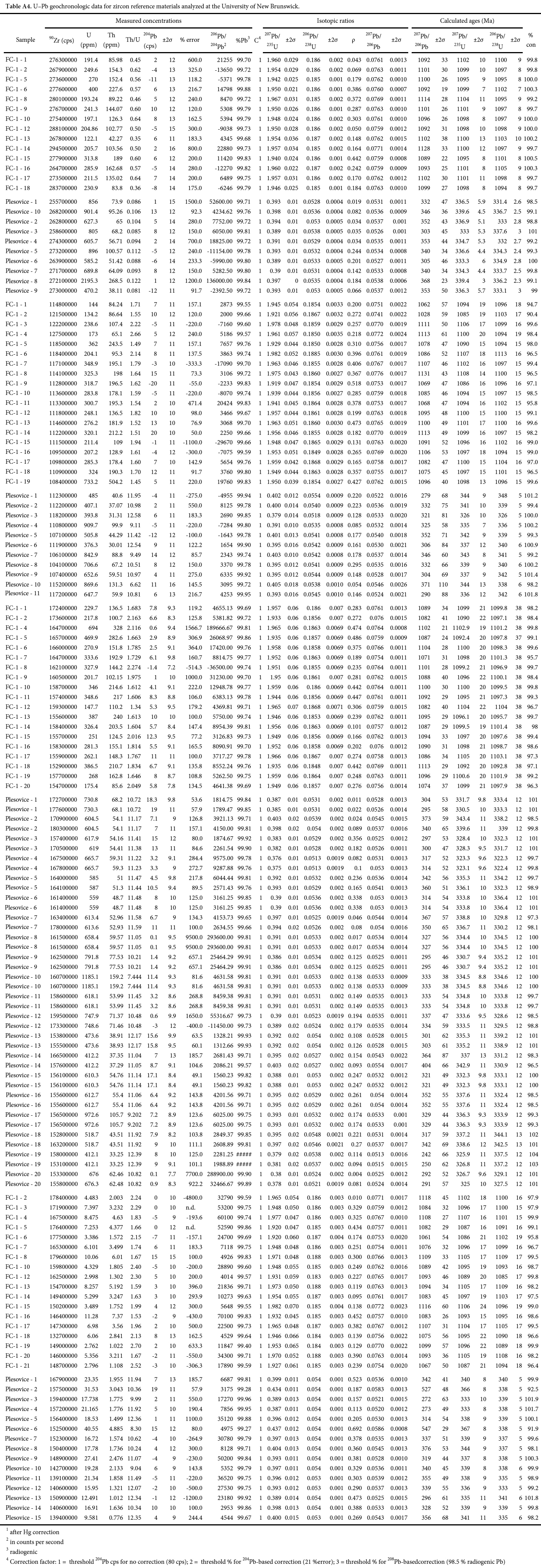 Display large image of Table 4
Display large image of Table 4
- after Hg correction
- in counts per second
- radiogenic
- Correction factor: 1 = threshold 204Pb cps for no correction (80 cps); 2 = threshold % for 204Pb-based correction (21 %error); 3 = threshold % for 208Pb-basedcorrection (98.5 % radiogenic Pb)